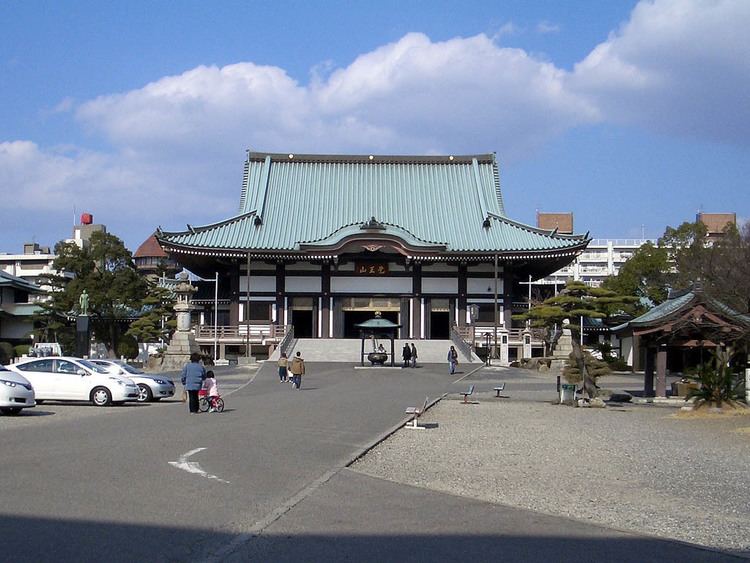Affiliation None Completed 1904 Phone +81 52-751-2121 | Opened 1904 | |
 | ||
Deity Gold-bronze statue of Buddha Similar Kakuōzan Station, Yōki‑sō, Tōgan‑ji, Kōshō‑ji - Nagoya, Higashiyama Sky Tower | ||
Kakuouzan Nittai-ji (Japanese:覚王山日泰寺, Japan-Thailand Temple) is a Buddhist temple located in the city of Nagoya, Aichi prefecture, Japan. Nittai-ji was built in 1904 in order to keep the ashes of Buddha, which the Kingdom of Thailand gave to Japan. ”覚王” means Buddha and “日泰” means Japan and the Kingdom of Thailand in Japanese. Usually, each temple in Japan belongs to a religious sect. However, Nittai-ji doesn’t belong to any religious sect. Every three years, 19 religious sects take their turn to dispatch a chief priest to Nittai-ji. Usually, the ambassador of the Kingdom of Thailand visits Nittai-ji on his birthday.
Contents
The discovery of the ashes of Buddha
In January 1898, a resident officer from Britain, William Peppe, discovered a pot of soapstone with human bones when he was excavating a tumulus close to the border of Nepal at Piprahwa.On the side of the pot, there are some ancient words written in 3rd century B.C. The meaning of the words is “The pot of the holy remains of Buddha is enshrined with a heart of trust by wife, children, brothers and sisters, together with a Sakya clan in India, Sakya”. Those words showed what is written in an old Buddhist text. That is “after Buddha died the remains were cremated and the ashes of Buddha was divided into eight. Some of the ash given to Syaka clan was kept in at Kapilavastu.” In the 19th century, almost all researchers thought Buddha was legendary. However, this discovery shows Buddha is not legendary. The government of India decided to keep the pot in The Indian Museum in Kolkata and gave the ashes of Buddha to the royal family of Thailand. King Chulalongkorn kept the ashes from India in Wat Saket and gave some ashes of Buddha to Buddhist countries like Ceylon and Burma. When a minister of Japan, Manjiro Inagaki, heard that news, he would like to have the ashes and asked the king to give the ashes to Japan, which is also a Buddhist country. The king decided to give the ashes to Japan as a gift from the royal family of Thailand to the Japanese people.
The funding of Nittai- ji
Mr. Inagaki sent a letter about receiving the ashes of Buddha to the foreign minister, Shuzo Aoki. Mr. Aoki immediately commanded all of the chiefs of Buddhist sects (13 sects and 56 sub sects) to prepare to receive the holy ashes. They held a conference and decided to receive the holy ashes. They organized a mission in order to receive the holy ashes in June 1900. The mission visited Thailand and received the holy ashes from King Chulalongkorn at the Roya Palace in Bangkok on 15th June 1900. When they promised King Chulalongkorn to build a new temple not belonging to any Buddhist sect in order to keep the holy ashes, King Chulalongkorn gave a gold-bronze statue of Buddha which was made a thousand years ago and which was a national treasure in Thailand to Japan as a main statue of Buddha in the new temple. After the mission brought back the holy ashes to Japan, the holy ashes were kept at Myohoin temple in Kyoto temporarily. The representatives from each Buddhist sect in Japan conferred about the new temple in order to keep the holy ashes. After many conferences, finally, they decided to build the temple in Nagoya. Nagoya city government prepared 330,000 square meters ground to build the temple. The Nissen-ji (now, Nittai-ji) showing friendship between Japan and Thailand was built in 1904.
Tower keeping the ashes
In this tower, the holy ashes of Buddha are kept on second floor. The height is 15m. This tower is an important cultural property designated by Aichi prefectural government. The tower was designed by Professor Chuta Ito of Tokyo University. The tower is made of granite. The style of the tower is Gandhara style. In front of this tower, there is a round hall for holding a celebratory ritual every year.
The present Dharma hall
This hall is the main hall of this temple. In this hall, the gold-bronze statue of Buddha is kept. In front of this hall, there is a signature of the current king of Thailand, King Bhumibol Adulyadej. The word, “Syakamuni Buddha”, is written as this signature in Thai language. At the west side of this hall, there is calligraphy written by Mr. Otei Kaneko. The calligraphy shows good friendship between Japan and Thailand.
Other architecture in this temple
King Chulalongkorn statue
This statue was built in commemoration of friendship between Japan and Thailand for 100 years in 1987. This statue is in front of the Dharma hall. In front of this statue, there are some flowers of Thailand (Kaikouzu) which the Crown Prince of Thailand planted in 1987.
Syozouno Baiyou
Baiyou was used as instead of paper in order to write down words. This temple keeps 37 Baiyous. In Syozono Baiyou, Buddhist scripture was written in Khmer and Thai language. Those Baiyous were given to Japan by Thailand but no one knows when.
The statue on the main gate
On the main gate, there are two statues. On the right side of this gate, there is a statue of Ananda Arhat, who was a disciple of Buddha and served Buddha until he died. On the left side of this gate, there is a statue of Mahakasyapa Arhat, who was the oldest disciple of Buddha and became a leader after Buddha died. The two statues were made by Mr. Katsuzo Entsuba in 1988.
Other treasures in this temple
Major Event
On the 21st day of every month, this temple holds Kobo Daishi fair and many shops open in front of the temple. This temple has some annual events.
